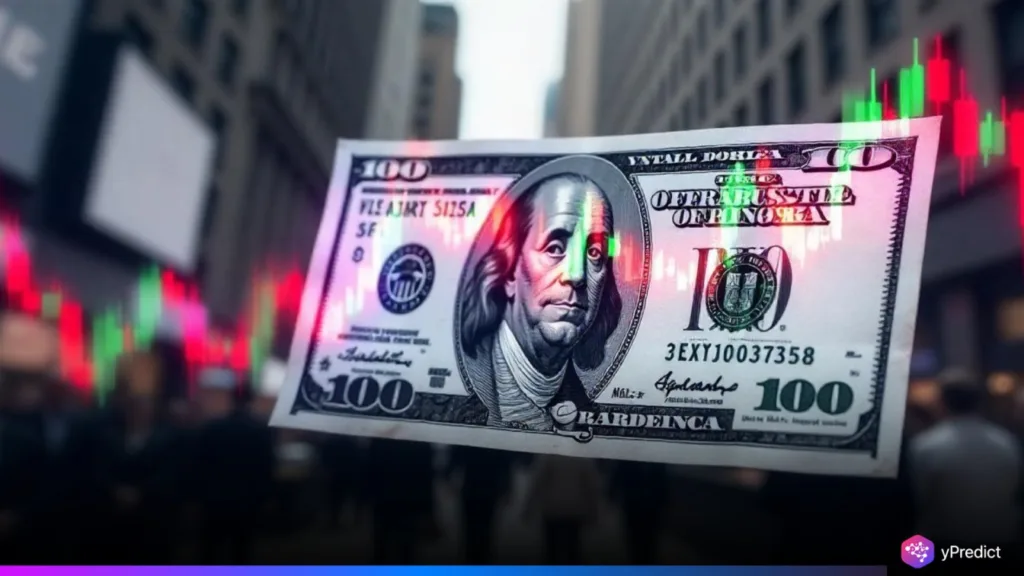
Dollar hits 3-year low as President Donald Trump escalates his criticism of Federal Reserve Chair Jerome Powell, igniting fresh concerns over the central bank’s independence. The U.S. Dollar Index (DXY) plunges below 97.00 after Trump accuses Powell of “sabotaging” the economy by refusing to cut interest rates. Global currency markets react sharply, with the yen, euro, and emerging-market currencies rallying. Analysts warn that growing political pressure on the Fed threatens to undermine investor confidence in U.S. monetary policy, potentially destabilising global markets as the election-driven feud intensifies.
Dollar Weakens Sharply Amid Political Pressure on the Fed
According to The Wall Street Journal, the U.S. dollar sank to a three-year low on Thursday, weighed down by escalating political pressure on the Federal Reserve and mounting concerns about its independence. The dollar index (DXY), which tracks the greenback against six major peers, fell below 97 for the first time since March 2022, touching an intraday low of 96.6.
The currency has now lost nearly 2% this week and more than 10% since the start of the year, putting it on course for its steepest first-half decline since the early 1970s, when currencies shifted to a free-floating system.
Investor anxiety deepened following reports that President Trump, frustrated with Powell’s cautious approach to interest rate policy, is seriously considering naming a successor well ahead of Powell’s term ending next May. Speculation points to an announcement as early as September or October. Such an unprecedented move would overshadow Powell’s leadership and raise further doubts about the Fed’s autonomy.
Trump’s repeated attacks, calling Powell “hardheaded” and “terrible”, have already fueled market unease, while his push for faster, deeper rate cuts threatens to heighten volatility.
As the dollar hits a 3-year low, demand for safe-haven assets eases after a U.S.-brokered ceasefire between Israel and Iran appears to hold. At the same time, Powell’s testimony before Congress reaffirms the central bank’s cautious stance. He warns lawmakers that premature policy shifts could impose lasting economic costs, remarks that only intensify the president’s frustration.
Global Stocks Extend Gains, Euro and Yen Strengthen
As the dollar hit a 3-year low, global stock markets rallied. The MSCI World Index climbed 0.4% on Thursday, marking its second record high this week and lifting year-to-date gains to nearly 8%. Europe’s STOXX 600 rose 0.2%, buoyed by the U.S.-brokered ceasefire between Israel and Iran, NATO’s pledge to boost defence spending, and anticipation of the European Union’s position ahead of trade talks with the U.S. In Asia, Japan’s Nikkei surged 1.65% to its highest level since January, while other regional indices saw modest gains.
In currency markets, the euro hit $1.173, its strongest since 2021, supported by dollar weakness, NATO’s defence commitments, and Trump’s more conciliatory tone toward allies. Analysts indicated that sustained gains above $1.17 could open the door to $1.20 if the greenback’s slide persists. The Swiss franc reached a 10-year high, and the yen strengthened below 144 per dollar as investors sought safer alternatives amid uncertainty over U.S. monetary policy.
Fed Independence Under Threat as Economic Risks Mount
Investor concerns deepened as conflicting signals from Washington added to policy uncertainty. President Trump ramped up calls for sharp rate cuts of two to three points, while Powell urged caution, warning Congress that tariffs could fuel price spikes and longer-term inflation, making premature easing risky. Analysts view Trump’s reported plan to name Powell’s successor early as an unprecedented move to pressure the Fed, with MUFG Bank’s Lee Hardman warning it could accelerate the dollar’s decline by signalling a shift toward a more dovish stance.
Furthermore, broader economic worries have added to the unease. JPMorgan has flagged a 40% chance of a stagflationary recession in the second half of the year, driven by trade tensions and policy uncertainty. As markets digest these risks, the dollar remains under pressure, and investors are bracing for further volatility in the months ahead.







